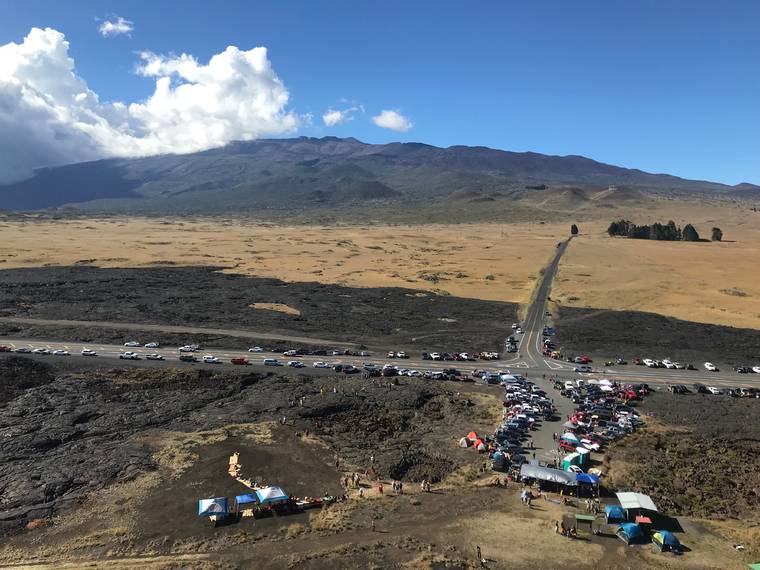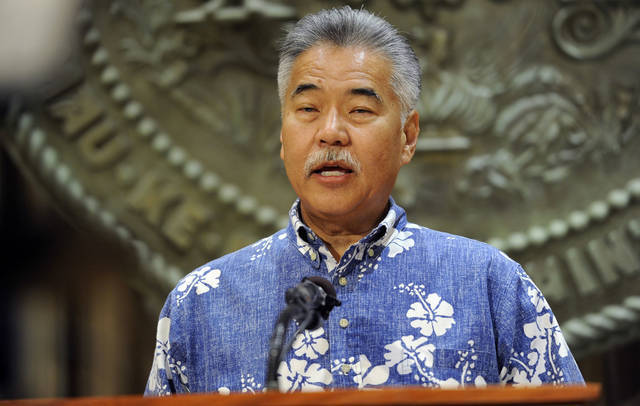PUU HULUHULU — With less than 24 hours before the Maunakea summit access road was expected to close in anticipation of the start of construction on the Thirty Meter Telescope, hundreds gathered here over the weekend offering oli, mele and prayers as part of a peaceful yet determined demonstration at the base of Maunakea.
While what exactly will happen when authorities arrive Monday morning to close the Maunakea summit access road remains to be seen, those on both sides reaffirmed a commitment to safety on Sunday.
“We expect there to be tension. We expect it to be intense,” said organizer Kahookahi Kanuha. “We’re not going to back down, but we’re not going to push and escalate things.”
State officials have also emphasized their commitment to safety on everyone’s part, and Gov. David Ige on Sunday afternoon rebutted a rumor of a “planned sweep” of the mountain that night, telling reporters no such action was in the works.
“We are concerned that these false rumors and speculation about state law enforcement activities creates anxieties in our community,” Ige said, “and we just really want to remind people that the men and women of law enforcement are your neighbors.”
But if there were anxieties, they weren’t enough to prevent hundreds from gathering at Puu Huluhulu, which stands across Daniel K. Inouye Highway from the Summit Access Road.
Throughout the day, people took the opportunity to offer oli at an ahu, join in a song or meal or immerse themselves in conversation and discussion with one another.
Meanwhile, others stood at the entrance and waved at passing traffic, which occasionally responded with a blow of the horn as it passed through the lines of cars parked along either side of the highway.
But the seriousness of what was at stake for them was also present, and for many, what happens next here is of enormous consequence.
“If you look at ‘em right now, once that thing goes up, it’s pau, right?” said John Keohiwa, a resident of the island’s Hilo side. “It’s like it’s almost done for all the Hawaiians.”
Kanuha said he believes the dispute about the TMT and Maunakea is often mischaracterized as a debate of “culture versus science,” or “tradition versus progress,” but he said that kind of framing isn’t quite it.
“We’re not against the science, we’re against the desecration of our land,” Kanuha said. “We are against not having control over our destiny and our future when that is something that we secured through international law in 1843, and we have never, ever, ever relinquished it. We never will. It’s a right to be Hawaiian.”
Likewise, Kapulei Flores, 19, of Waimea, said her position on the issue has little to do with what’s being constructed.
“We’ve said since the beginning it’s not about science,” she said. “It could be any building.”
Instead, she said, it’s about the sheer size of the $1.4 billion observatory and the effects development could have.
“For us, it doesn’t even matter that it’s science. We’re not fighting astronomy,” she said. “A lot of our ancestors were amazing navigators. They used the stars, they read the stars. That’s how they voyaged. So we’re definitely not against astronomy and science.”
Ige, in comments to reporters, said he’s offered to meet with those opposed to the telescope’s construction on Maunakea, but said it’s all been declined so far.
“We continue to have conversations with different groups if they would like to have it,” he said.
Kanuha, however, said ultimately there is no compromise to be had.
“The compromise I can see is: You leave the mountain and we leave. You go to the Canary Islands and we leave,” Kanuha said, referring to the project sites second choice for locating should Maunakea not work out. “That’s the only discussion there is to have. I cannot even fathom anything that could be compromised. It’s build it or don’t build it.”
Mayor Harry Kim, who visited the site briefly on Sunday afternoon, said the issue isn’t just about Maunakea, but about things “ever since way back.”
“And this is symbolic of that,” he said. “And I think it is up to us to understand that, important for us to respect that and important for us to address those things we should address.”
Ige said he couldn’t comment as to what provisions law enforcement will have on site, but said they’ve been preparing “in a number of different ways, and we are prepared to respond to whatever the situation may be.”
The project is expected to take years to complete and comes after nearly five years of delays, which included heavy protests and road blockades to the construction process in 2014 and 2015.
“We expect, and I expect, the best behavior from our community,” Ige said. “We don’t expect protesters to get out of line, but in terms of preparation, law enforcement has gone through and prepared for every scenario you might be able to imagine.”
And Flores meanwhile also stressed a focus on safety for everyone at Puu Huluhulu.
“I just want everyone to be safe,” she said. “And even if there are arrests, because that’s probably going to be hard to avoid, I just want it to be — if there is arrests — to be in the safest way possible for everybody: the police who’s arresting and for us.”




